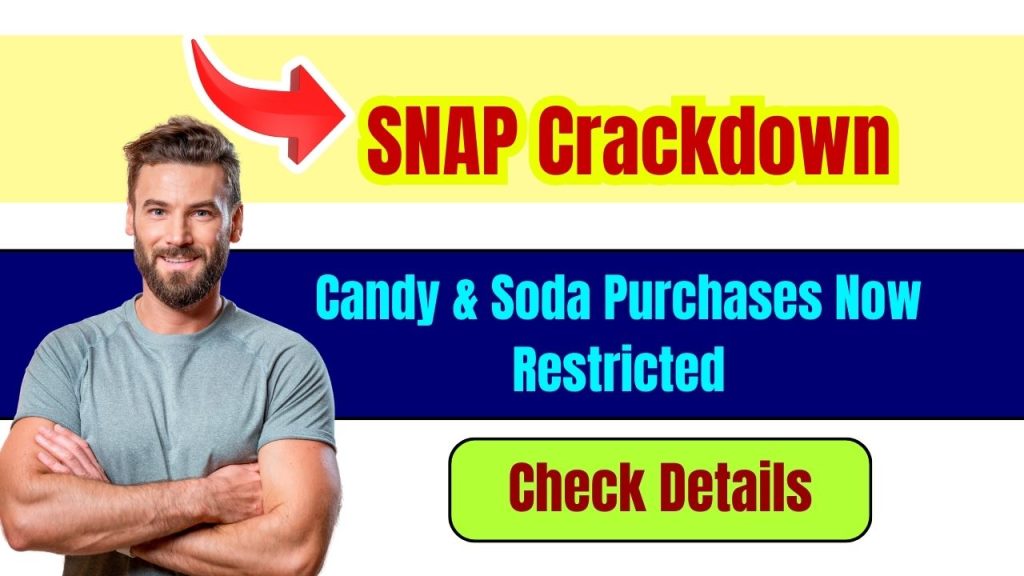SNAP Crackdown: A new wave of policy changes is sweeping across the United States, and it directly affects millions of low-income Americans who rely on the Supplemental Nutrition Assistance Program (SNAP). The focus of this latest crackdown? Candy and soda purchases using SNAP benefits.
As of early 2025, several states, including Idaho and Texas, are pushing forward legislation to restrict SNAP users from buying certain sugary and processed items. This move aims to promote healthier eating habits and reduce the long-term health risks associated with excessive sugar consumption. As the conversation around nutrition, chronic illness, and public spending becomes more urgent, these measures represent a significant shift in how we view food assistance in America.

SNAP Crackdown
| Topic | Details |
|---|---|
| Policy Focus | Restricting candy, soda, and junk food purchases with SNAP benefits |
| States Involved | Idaho, Texas, others considering similar moves |
| Effective Dates | Idaho: July 1, 2025 (pending USDA approval) |
| Official Resource | USDA SNAP Information |
| Supporters Say | Encourages healthier food choices, lowers public health costs |
| Critics Say | Could stigmatize users, limits food autonomy, may not account for food access issues |
| Federal Approval Required? | Yes, states must obtain waivers from the USDA |
| Additional Reading | Fox 26 Houston |
The SNAP crackdown on candy and soda purchases reflects a growing effort to align public assistance with public health goals. While this policy shift is still unfolding, it marks a turning point in how we approach nutrition, poverty, and healthcare in America.
As states like Idaho and Texas take the lead, it’s important for SNAP users, retailers, public health experts, and advocates to stay engaged and informed. These policies offer both challenges and opportunities—from improving health outcomes to addressing systemic inequalities in food access. Understanding these changes and participating in community conversations will be key to navigating this evolving landscape.
What Is SNAP and Why Does It Matter?
SNAP, formerly known as “food stamps,” is a federal assistance program designed to help low-income families afford groceries. Over 41 million Americans rely on SNAP to put food on the table, according to USDA statistics.
The program plays a crucial role in combating food insecurity, supporting both families and the economy. For every $1 in SNAP benefits, about $1.50 is generated in economic activity. This makes it not just a social welfare tool but also an important economic stimulus, especially in underserved communities.
Recipients receive monthly benefits via an Electronic Benefits Transfer (EBT) card, which works like a debit card but is restricted to eligible food purchases. SNAP benefits can be used at most grocery stores and many farmers markets. While the program has always included certain limitations (such as restrictions on alcohol, tobacco, or hot prepared meals), this new push to include candy and soda represents a broader effort to align the program with nutritional best practices.
Why Are Candy and Soda Being Targeted?
Supporters of the ban argue that sugary snacks and drinks contribute to obesity, diabetes, and heart disease. With taxpayer money funding SNAP, lawmakers are pushing to align public spending with public health outcomes.
For example:
- Sugary drinks are the leading source of added sugars in the American diet.
- Over 73% of U.S. adults are overweight or obese (CDC data).
- Approximately 1 in 10 Americans has diabetes, according to the CDC.
- Diet-related illnesses cost the U.S. economy over $260 billion annually.
The logic is clear: if SNAP funds are going to support food purchases, they should ideally encourage nutritious options that support long-term health and reduce the burden on the healthcare system.
Which States Are Leading This Change?
Idaho
In March 2025, Idaho lawmakers passed House Bill 109, banning SNAP purchases of soda and candy. The bill awaits Governor Brad Little’s signature and USDA approval. If greenlit, it will take effect on July 1, 2025.
Idaho officials argue that the bill aligns with the state’s broader public health initiatives and aims to reduce rising rates of childhood obesity and diabetes. Proponents also believe that this will foster greater nutritional awareness and support the local agriculture industry by shifting spending toward whole foods.
Texas
Texas Senate Bill 379, introduced by State Senator Mayes Middleton, takes a similar approach. It passed the Senate and is now under review in the House. If approved, it will also require a federal waiver before implementation.
Texas legislators have framed this move as both a health and fiscal responsibility issue. With Texas facing high healthcare costs linked to poor nutrition, the bill is seen as a proactive step toward prevention.
Other States
States like Mississippi, Arkansas, and Missouri have also expressed interest in implementing similar bans. Lawmakers across these regions are watching how Idaho and Texas navigate implementation and USDA cooperation.
How Will This Affect SNAP Users?
The impact on SNAP users will likely vary depending on individual circumstances and access to healthy alternatives. Here are some expected outcomes:
Potential Challenges:
- Limited food choices, particularly for individuals living in food deserts where affordable, healthy foods are scarce.
- Checkout confusion, as definitions of “candy” and “soda” may not be consistent across different retail systems.
- Increased stigma, as critics argue that restricting choices implies a lack of trust in SNAP recipients’ decision-making.
Possible Benefits:
- Improved public health, especially among children and vulnerable populations.
- Enhanced education around balanced eating, driven by public campaigns and community outreach.
- Support for local producers, as healthier options often include fresh, regionally sourced ingredients.
- Reduced healthcare costs, potentially easing the strain on publicly funded health services.
What Counts as Candy or Soda?
The USDA has not released a definitive list, but the general guidelines include:
- Candy: Chocolate bars, hard candies, licorice, gummies, caramel-based treats, taffy, and candy-coated items.
- Soda: Sugar-sweetened carbonated beverages such as cola, root beer, and lemon-lime sodas.
Other potentially restricted items include energy drinks, sports drinks, and sweetened flavored waters. However, exact definitions may vary by state or retailer.
To ensure clarity, states will likely work with retailers and third-party vendors to build and maintain a database of restricted UPCs (Universal Product Codes).
What Happens Next?
The rollout of these new SNAP restrictions involves several steps and key stakeholders:
- Governor Approval: State governors must sign the legislation into law.
- USDA Waiver: The state must apply for and receive a waiver from the U.S. Department of Agriculture.
- Retail Integration: Point-of-sale systems must be updated to flag and reject purchases of banned items.
- Public Awareness: States will likely launch campaigns to help SNAP recipients understand the changes and offer educational materials about healthy eating.
- Monitoring & Evaluation: Expect follow-up studies to measure the impact of these changes on public health, food security, and shopping behaviors.
These steps could take several months, and delays may occur if there is pushback from advocacy groups or logistical challenges during implementation.
$975 SNAP Payouts Confirmed for April 2025 – Check When You’ll Get Yours!
$292, $431, or $517 SNAP Payments Deposited Soon – Check Your EBT Card Now!
SNAP Benefits Worth $975 for 4 Will Be Issued April 1: How to Check If You’re Eligible
FAQs About SNAP Crackdown
Can I still buy candy and soda with cash if I receive SNAP?
Yes. The restrictions apply only to purchases made using SNAP benefits (EBT cards). You can still use cash or other personal funds for these items.
Will these changes affect WIC or other benefit programs?
No. These changes apply only to the SNAP program. The Women, Infants, and Children (WIC) program already includes nutritional guidelines and does not allow candy or soda purchases.
How will stores know what items are banned?
Retailers will receive updated Point of Sale (POS) software and access to a product list developed in coordination with the USDA or third-party providers.
What if I accidentally buy a banned item?
If you try to purchase a restricted item using SNAP benefits, the transaction for that item will be denied. You can still pay out-of-pocket if you choose to buy it.
Where can I find healthy, SNAP-eligible recipes?
You can visit MyPlate.gov for healthy, budget-friendly recipes and nutrition tips designed for SNAP recipients. You can also contact your local SNAP-Ed agency for classes and resources.
Additional Resources
- USDA Food and Nutrition Service
- Feeding America
- Centers for Disease Control and Prevention











